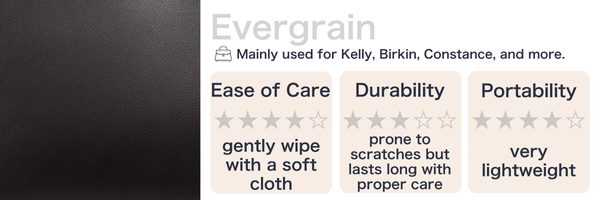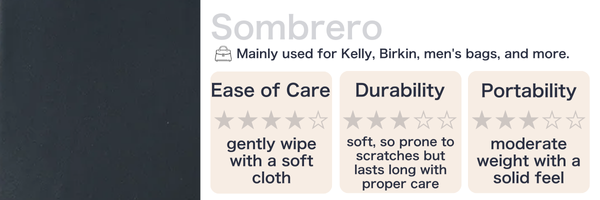| Togo leather▼ |
 |
| Features a coarse grain pattern that is scratch-resistant, flexible, yet holds its shape well. |
| Clemence leather▼ |
 |
| Has a soft and supple texture that develops character with use. Scratch-resistant and highly durable. |
| Taurillion Novillo▼ |
 |
| Has a fine grain pattern and moderate firmness, lightweight and resistant to losing its shape. |
| Taurillon Maurice▼ |
 |
| Soft with a fine grain pattern and moderate luster. |
| Veau Grain Lisse(VGL)▼ |
 |
| A male calf leather with beautiful luster, treated with both glazing and pressing. Known for its resistance to scratches and stains. Discontinued in 2003, with Epsom leather now serving as its successor. |
| Veau Swift▼ |
 |
| Features a smooth and soft texture. Known for its excellent color absorption, capable of expressing vibrant hues. |
| Veau Volupto▼ |
 |
| Characterized by its fine grain pattern and moist texture, with a softness that feels like it clings to your hand. |
| Barenia Faubourg▼ |
 |
| Features a relaxed texture with just the right amount of elasticity, characterized by its distinct textural relief and the natural, subtle sheen inherent to the leather. |
| Doblis Suede/Suede-processed leather▼ |
 |
| Has a soft, fluffy suede texture that gives a warm and elegant impression. |
| Veau Sikkim▼ |
 |
| Characterized by its glossy finish and strong embossing. Currently discontinued, with Vache Liegee as its successor. |
| Ardennes▼ |
 |
| Leather from female cows from the Ardennes region of northern France and southern Belgium. Known for its glossy finish and strong embossing. Currently discontinued, with Vache Liegee as its successor. |
| Veau Barenia▼ |
 |
| Has a matte texture similar to natural untreated leather. Features elasticity and develops a rich patina with use. |
| Butler leather▼ |
 |
| Has a matte texture and elasticity, with a delicate, subtle shine. With use, the leather's natural oils create a unique luster, and the color deepens. |
| Veau Graine Courchevel▼ |
 |
| Features fine embossing and glazing treatment, resistant to dirt and scuffs, lightweight with beautiful color expression. Currently discontinued, with Veau Epsom as its successor. |
| Evercalf leather▼ |
 |
| A smooth leather with a sleek feel and elegant shine. Develops more luster with use, evolving into a rich, deep texture. |
| Evergrain▼ |
 |
| An embossed material characterized by its fine grain pattern and smooth texture. Soft and easily conforms to the hand. The color version of this material is called Evercolor. |
| Evercolor leather▼ |
 |
| The color version of Evergrain. Characterized by its firmness, slightly rigid touch, and matte finish. Develops a luster and becomes more supple with use. |
| Fjord▼ |
 |
| A female calf leather with coarse embossing, featuring moderate flexibility and elasticity. Excellent durability makes it suitable for everyday use. |
| Grain d'H▼ |
 |
| A male calf leather featuring fine embossing with a continuous pattern of Hermès' "H" design. Highly durable and scratch-resistant. |
| Grizzly▼ |
 |
| A suede-processed male calf leather. Characterized by its soft touch and matte texture, developing more character with use. |
| Madame▼ |
 |
| A male calf leather characterized by its fine embossing and subtle shine, featuring an elegant texture. |
| Graine Monsieur▼ |
 |
| A male calf leather with fine embossing, characterized by its slightly firm touch. Creates a structured appearance and is commonly used in items like the Constance and Birkin bags. |
| Natural Graine▼ |
 |
| A male calf leather characterized by its matte texture achieved through pressing while preserving its natural character. |
| Negonda▼ |
 |
| A male calf leather introduced in 2007. Features large-grain embossing. |
| Sombrero▼ |
 |
| A male calf leather introduced in 2011. Has a smooth texture and subtle shine similar to Box Calf, but is smoother and has more structure than Box Calf. |
| Tadelakt▼ |
 |
| A male calf leather characterized by its smooth texture and shine similar to Box Calf. Its smooth surface creates an elegant impression. |
| Vache Hunter▼ |
 |
| A male calf leather characterized by its slight shine and smooth touch. Has a firm texture with fine grain and smooth surface. |
| Veau Chamonix▼ |
 |
| Male calf leather from Chamonix in the French Alps at the foot of Mont Blanc. Characterized by its smooth texture and a material feel similar to Box Calf but with a slightly more matte finish. |
| Veau Chéri▼ |
 |
| Characterized by its smooth touch and elegant shine, creating a refined impression. |
| Veau Gulliver▼ |
 |
| Characterized by its extremely soft, smooth texture. Features fine, subtle embossing and develops more character with use. |
| Veau Troika▼ |
 |
| A material made from dyed and processed male calf hair, also known as pony hair. Characterized by its smooth touch and glossy, beautiful fur texture. |
| Jonathan▼ |
 |
| A smooth material with almost no visible grain pattern. Creates an elegant impression with its moderate softness, subtle shine, and matte texture. |
| Country▼ |
 |
| A material introduced in 2012. Features pressed embossing and is characterized by its slight firmness and rigid touch. |
| Box Nepal▼ |
 |
| A material introduced in 2001, characterized by its smooth touch without glazing treatment. Was used in items like the Air Bag, but is now rare. |
| Box calf leather▼ |
 |
| Characterized by its smooth surface and beautiful sheen, giving a formal impression. |
| Derma leather▼ |
 |
| A leather with matte texture introduced in 2004, processed to be thin and smooth. Highly flexible and can be crafted into various shapes. |
| Taurillon Cristobel▼ |
 |
| Characterized by its soft touch. Mainly used in men's bags and leather items. |
| Waffle▼ |
 |
| A special material created by embedding wire into leather. Characterized by its relaxed softness and waffle-like textured pattern. Said to have been developed specifically for the Kelly bag. |
| Vache Liegee▼ |
 |
| A material introduced in 2004 and now discontinued. Characterized by its moderate shine from press treatment and firm surface texture. |
| Vache Natural▼ |
 |
| A traditional Hermès material that develops a mature color through aging. Available in two colors - black and natural. Characterized by its smooth and soft texture. |
| Vache Trekking▼ |
 |
| A material introduced in 2009, characterized by its firm touch and fine grain pattern. Resistant to visible scratches and stains. Available in limited color variations. |
| Veau Miroir▼ |
 |
| A refined material with a glitter-like shine and pearlescent quality. Has a firm touch and no embossing. |
| Veau Rodeo▼ |
 |
| A male calf suede material also known as nubuck. Frequently used in apparel and accessories, but rare in bags. |
| Villandry▼ |
 |
| A material introduced in 2016, characterized by its smooth touch and shine that increases with age. Named after the Château de Villandry in France. |


